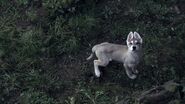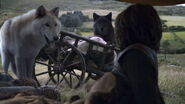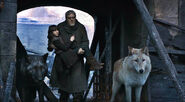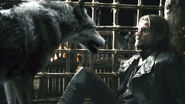- "Tough old beast."
- ―Eddard Stark

Ned Stark and his sons find a dead female direwolf, and her six newborn cubs.
A direwolf is an unusually large and intelligent species of wolf. A grey direwolf on a white field is the sigil of House Stark.
Range
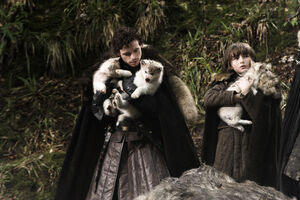
Robb and Bran Stark find some direwolf cubs
Direwolves are held to be near-mythical in most of the south of Westeros. Inhabitants of The North acknowledge that they are a real animal, but they are very rarely encountered there. There are some rumors of them living in the Wolfswood near Winterfell, but these are unconfirmed. There may have been larger direwolf populations in the North in past millenia, but centuries of human encroachment on their territory have pushed their range back to the furthest north.
There have been confirmed sightings north of the Wall by the Night's Watch who guard it. The wildlings who live beyond the Wall claim that direwolves can be found in greater numbers in the Haunted Forest to the north of the Wall. When the series begins (during the reign of King Robert Baratheon) no direwolf has been sighted south of the Wall, even in the Stark lands of the North, in over 200 years.
Biology

A year-old juvenile direwolf, already taller at its shoulder than a man's waist
An adult direwolf is as large as a small horse, and can rip a man's arm from its socket. Even a juvenile direwolf is quite capable of killing a man by ripping out his throat. Physically they are not simply larger versions of wolves, but have slightly different proportions than their smaller cousins: their heads are larger with a leaner, more pronounced muzzle; their legs are longer in proportion to their body, and they have proportionately larger teeth that are often used to crush bones.
Named direwolves
Template:CastPortalDireWolf
The children of House Stark adopt six orphaned direwolf cubs found in the Wolfswood. They are as follows:
- Grey Wind, adopted by Robb Stark. Currently with the main Stark army in the South, used by King Robb as a ferocious war dog.
- {Lady}, adopted by Sansa Stark. Lady is killed under orders of Robert Baratheon, at the urging of Cersei Lannister.
- Nymeria, adopted by Arya Stark. Fearing for Nymeria's life, Arya chased her away after the wolf cub attacked Prince Joffrey Baratheon to defend her owner. She is now loose somewhere in the Riverlands, the first direwolf seen that far south (other than Grey Wind) in many centuries.
- Summer, adopted by Bran Stark. Fled Winterfell with Bran following the castle's sacking.
- Shaggydog, adopted by Rickon Stark. Likewise fled Winterfell with Rickon.
- Ghost, adopted by Jon Snow. An albino with red eyes, Ghost followed Jon to his service with the Night's Watch at the Wall and beyond.
Behind-the-scenes

Nymeria, portrayed by an adult dog in Season 1.
- In Season 1, the production team used adult dogs to stand in for the juvenile direwolf puppies. Northern Inuit Dogs from Mahlek Kennels were used.[1] In interviews they have stated that this was done to allow the audience to grow attached to them, which would have been more difficult had the dogs been created by special effects. As the direwolves continue to grow, however, more special effects are going to be used.
- When Season 1 wrapped up, the dogs used as direwolves were offered to the young actors who played their owners in the show. Sophie Turner who played Sansa Stark took the dog who played Lady. Isaac Hempstead-Wright who plays Bran wanted to take Summer, but they already had two dogs at home.

Ghost, played by a real wolf in Season 2, digitally resized to look even bigger
- In Season 2, real wolves were used to portray the adolescent direwolves. Using a variety of camera tricks and techniques, the shots were augmented to make the wolves appear larger, and then composited with the background and actors for the final shots. The result is that in Season 2 the direwolves are played by real-life wolves that have been super-sized in post-production.[2]
In real-life
Direwolves were an actual species of Pleistocene megafauna that once existed on real-life Earth, like the mammoth and sabertooth cat. Direwolves inhabited the Americas, from 1.8 million years ago to about 10,000 years ago.
The large Pleistocene mammals went extinct when the last ice age ended, roughly 10,000 years ago. Large herbivores like the mammoth died out due to climate change (and possibly hunting by prehistoric humans), and carnivores such as direwolves died when their food sources disappeared. Direwolves and mammoths were adapted to the cold ice age climate, their size maximizing heat retention and strength but at the cost of speed. In the warmer climate following the ice age, smaller but faster animals thrived that didn't need to make these tradeoffs for cold weather. Not only did direwolves' old large prey such as mammoths die out, but they were being out-competed by smaller and faster grey wolves.
Gallery
See also
References
Template:Creatures

